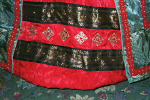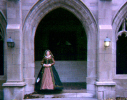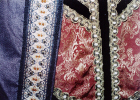|


Click to enlarge any photo.

|
| And
from the back |
| The gold locket that
I'm wearing in these photos has a large pearl embellished 'S' on it and
I'm planning on adding as many more 'S' items as I can find in the correct
style as well as any other Scrope heraldic emblems such as Cornish chough
(it's a kind of bird that looks like a crow only with a red beak and legs,
good luck finding one!) and a spray of 5 feathers (not the Prince of
Wales' 3 feathers). A gown may be done, but it's never complete! |

 |
Tawney
Hunting Gown - I decided
to make myself an outfit with no Courtly pretensions whatsoever, something
that was practical yet stylish, sporty yet elegant. So I dived into
my fabric stash to see what looked promising. I found a nice pile of
tawney (period term for a dark reddish brown sometimes referred to as
'rust' today) brushed cotton twill and some metallic gold brocade- not
much but enough for a jerkin. That looks like a good start to me! I
decided that since this was to be a sporting outfit, I would sew the skirt
to the bodice and have it closed up the front. I found some
black/tawny/gold/ trim left over from a previous project as well as some 'tabac'
Swarovski crystal beads and some black bugle beads to embellish it. This
wasn't costing me a dime! Yay me! |



| Black
Velveteen -
Third Incarnation - |


 |
 |

|

|
|
This is a 16th
century Flemish peasant dress that I made from instructions by Drea Leed
(see the link to The Elizabethan Costume Page). Although she based
her research on Flemish paintings of the period, there is a great deal of
evidence that dresses almost identical to this one were worn in England as
well. The gown is made of charcoal grey wool lined with yellow cotton, the
kirtle or petticoat bodies is made of blue linen/cotton blend, and the
shift is made of white linen. |
This is a garment
called a Spanish surcoat or a Ropa. It was fashionable in Elizabeth's
reign both for full court functions and for more relaxed activities. It
consists of a crimson satin and brocade kirtle (underdress) cut as an
A-line dress, with a teal and multi-colored brocade surcoat over it. The
sleeves tie into the kirtle. |
The
back of the surcoat has pleats controlling the fullness at the shoulders
with lines of crimson braid over gold trim hiding the stitching |
This
detail shows the sari trim I used along with the gold filigree pieces to
produce the decoration along the hem of the kirtle. It also shows more of
the series of separate elements I used to produce the lines of trim around
the front opening and hem. The base is metallic gold trim @ 3/4 inch wide.
Over that I laid crimson braid so that the metallic gold shines thru the
crimson and, to top it all off, I sewed fresh-water pearls in all the
central loops of the braid. It's true, I have no life. |


 |

|

|

|
|
The
final layer of the costume is the surcote. Mine is made of a woven brocade
imitating Chinese silk. |
This is a black brocade Elizabethan with a
square necked English/French style bodice. The forepart (decorative
panel on front of the undershirt) sleeves and partlet are of dark red and
gold brocade jeweled with amber and dark red crystals. |
I made this gown
from a wale-less corduroy in an interesting dark grey/brown color which
seems to me the color that might have been called 'sadde' or 'rat's color'
in the Elizabethan period. I've chosen to go with 'sadde' as the official
color of the dress. Not that I have anything against rats..... |
This
is a detail shot of the trims used on the gown and forepart. You may
recognize the tawny and gold brocade forepart and sleeves from the black
brocade mix-n-match dress- here's a good look at the black velvet ribbon,
gold trim, and freshwater pearls which I used to decorate the set. On the
gown you see a brocaded trim with Swarovski crystal beads sewn on as added
decoration and the lines of black rayon (silk substitute) braid sewn along
side to finish look. |
|
